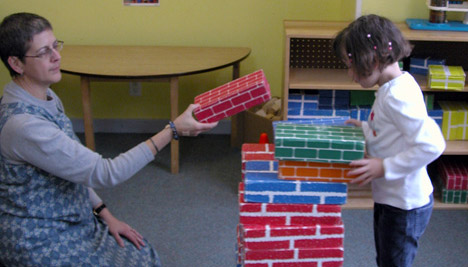
Like many things in life, communication is a two-way street. It is an active partnership between people that involves more than words. We communicate with each other using speech, gestures, touch, and facial expressions.
Children with special needs may communicate in ways that are difficult for other people to understand. Successful communication involves both understanding and being understood by others.
As a parent, teacher or early childhood professional, you can help your child understand you by:
- Looking at his face when you are speaking to him.
- Emphasizing or stressing important words by saying them a bit louder.
- Speaking slowly and clearly.
- Using gestures, objects, or pictures to match your words.
- Repeating parts of questions or instructions.
You can help your child express himself by:
- Giving him time to respond to you.
- Providing him with visual aids such as objects and pictures.
- Starting sentences and encouraging him to complete them.
- Responding to his communication attempts.
If your child has a speech and language delay, a vision or hearing impairment, a Speech Language Pathologist or agency support person can provide you with special techniques to help your child communicate.
Encouraging your Child to Communicate
Before moving on, it is helpful to think of what your child’s communication attempts might look and sound like. Here are some examples:
- Looking at an object, activity, or person.
- Reaching for or pointing to an object, activity or person.
- Pulling another person towards an object or activity he wants.
- Gesturing to show what he wants or does not want.
- Using sounds or words to say what he wants or does not want.
There are many things you can do at home or in the classroom on a daily basis to develop your child’s communication skills. The strategies that follow can increase your child’s ability to express his needs and wants. The key is to be consistent in your expectations of his response.
For example, if you are teaching your child how to gesture “more” rather than grab when he wants something, respond to any attempts he makes to gesture. Initially, another adult or older sibling can help by guiding your child’s response. This person can show him what to do by modeling the gesture or physically positioning him. It is important to respond positively to your child’s communication attempts so that he experiences success and is motivated to continue communicating with you.
Communication “Temptations”
Put a small toy that your child likes in a container that he finds difficult to open on his own. Give him the container and show him the toy inside. Wait for him to ask for help opening the container. As soon as he responds by passing you the container or gesturing for you to open it, open the container and give him the toy. You can say, “Oh you want the car. Let me take it out.”
More!
Encourage your child to ask for more of something he enjoys. Begin an
activity that he enjoys then stop. Wait for a few moments and encourage him to ask for “more” using sounds, words, gestures or pictures. As soon as he makes an attempt to say “more”, continue the activity.
Here is an example using bubbles:
Take a container of bubbles and show it to your child. Open the container and begin blowing bubbles. This is the fun part! Encourage your child to look at and touch the bubbles. Show him how to pop bubbles and make popping sounds together. When the bubbles have disappeared, put the cap back on the container and ask your child if he would like more bubbles. Wait a few moments. If your child looks interested, encourage him to ask for more by gesturing, pointing to the container, saying “more” or “bubbles”. When he responds say, “You want more bubbles”. Blow more bubbles!
Try stressing these words:
- “Open”
- “Bubbles”
- “Blow”
- “Pop”
- “More”
- “Want”
- “Finished”
Here are some other ways to encourage your child to ask for “more”:
- Pour a little bit of juice into a glass.
- Play some music he enjoys and then turn it off.
- Tickle, bounce or lift him in the air one time and then stop.
Making Choices
Before presenting your child with a choice make sure that there are few distractions and you have his attention. Begin by giving him a choice between two objects or activities. Show and name each choice when offering it to your child. For example, “Do you want crackers (hold up cracker box) or cookies (hold up cookie box)?” When both choices have been presented, give him some time to choose. You might need to prompt him by saying, “I want___________”. In this case, he might respond by pointing to the cookie box or saying, “cookie”. Once your child has made a choice, repeat it out loud and follow through by giving him the object or starting the activity. For example, “Oh you want cookies.”
You can also teach your child to make choices using a choice board like the one pictured below. He can point to the item he wants.
Play
Play time is an excellent time to build your child’s communication skills. Try to use toys that are fun and can teach a variety of skills. For example, “Mr. Potato Head” can increase your child’s vocabulary and fine motor skills. Talk to him as you play and show him how to create different funny faces.
You can build your child’s vocabulary by using action words such as “in”, “out”, “on” and talking about:
- Colours
- Body parts
- Clothing and accessories
Mr. Potato Head becomes a communication “temptation” when you put the pieces inside and shut the door.
